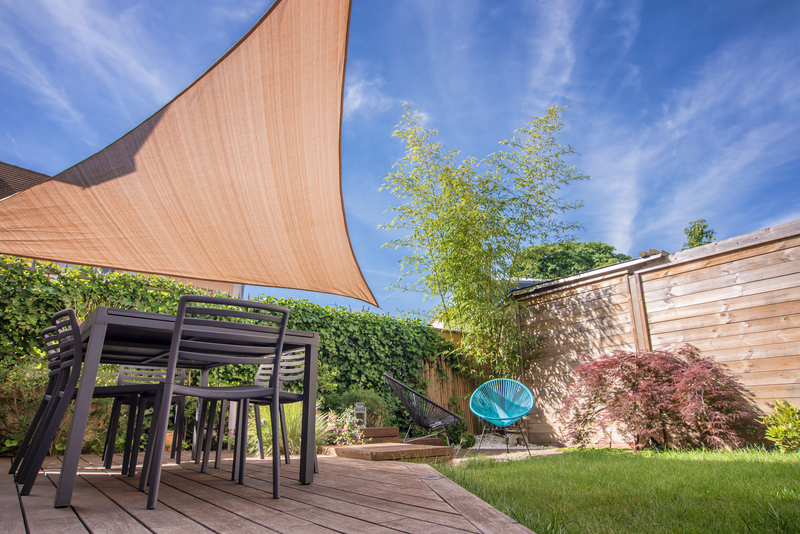Nature-Inspired Solutions to Enhance Backyard Privacy with Landscaping
Looking to create a serene retreat in your own backyard? Nature-inspired privacy landscaping offers an eco-friendly, attractive, and effective way to shield your outdoor spaces from prying eyes--without resorting to harsh barriers or artificial screens. In this thorough guide, you'll discover a range of plant-based and natural privacy solutions, design ideas, and pro tips to transform your backyard into a peaceful sanctuary.
Why Choose Nature-Inspired Landscaping for Backyard Privacy?
Unlike solid fences or industrial screens, nature-inspired solutions for backyard privacy are both sustainable and visually appealing. They blend seamlessly with your landscape, support wildlife, and enhance your garden's microclimate, all while effectively improving privacy. Let's delve into the major benefits:
- Environmental sustainability: Natural privacy features promote biodiversity and air purification.
- Aesthetic appeal: Lush, layered greenery adds texture, color, and seasonal interest.
- Noise reduction: Dense plantings can absorb and deflect sounds from nearby roads or neighbors.
- Customizable design: Choose from tall hedges, fast-growing trees, vines, or ornamental grasses to suit your taste and needs.
- Cost-effectiveness: Many plants are less expensive and longer-lasting than manufactured barriers.
Choosing privacy landscaping inspired by nature means creating a space that is both personal and harmonious with the environment.

Key Elements of Private Outdoor Spaces Inspired by Nature
To maximize privacy and beauty, consider including a combination of these backyard privacy landscaping elements:
- Tall, dense hedges: Provide year-round screening and a classic look.
- Layered plantings: Combine trees, shrubs, and perennials for depth and coverage.
- Trellises and arbors with climbing vines: Create vertical interest and living green walls.
- Evergreen borders: Offer privacy in all seasons.
- Natural berms or earth mounds: Elevate soil to form subtle, attractive barriers.
- Native ornamental grasses: Swaying grasses lend movement and obscure sightlines.
- Water features: Fountains or babbling brooks mask sound and attract wildlife.
- Strategic landscaping and positioning: Direct views and access points away from neighbors.
Let's explore each of these in depth and learn how to implement them as effective landscaping privacy solutions.
Best Plant Options for Natural Backyard Privacy
Choosing the right plants is essential for effective and enduring backyard privacy landscaping. Here are top categories and plant recommendations for various climates and settings.
1. Living Hedges
Living hedges are a timeless option for blending natural privacy landscaping with classical elegance. They can be trimmed for formal appeal or left loose for a wild, woodland look.
- Boxwood (Buxus): Slow-growing, evergreen, and easy to shape. Best for formal gardens.
- Privet (Ligustrum): Fast-growing and very dense. Effective screening for large spaces.
- Arborvitae (Thuja occidentalis): Tall, narrow, and reliable in cold climates.
- Holly (Ilex): Glossy leaves, often with red berries for winter interest.
- Cherry Laurel (Prunus laurocerasus): Broad-leaved evergreen, lush and quickly forms a barrier.
2. Fast-Growing Privacy Trees
When quick coverage is needed, opt for fast-growing privacy trees that reach impressive heights and create an instant natural wall.
- Eastern Red Cedar: Evergreen, provides excellent year-round screening.
- Italian Cypress: Tall and slender, ideal for narrow spaces.
- Bamboo: Absorbs noise, grows rapidly, and creates an exotic atmosphere. (Use clumping types to prevent spreading.)
- Leyland Cypress: Rapid growth, dense foliage, and versatile for different climates.
- Hybrid Willow: Extremely fast (up to 10 feet per year!), great for rural or suburban spaces.
Research your local area's recommended species to ensure the best fit for climate and maintenance needs.
3. Ornamental Grasses for Screening
Tall and swaying, ornamental grasses can form soft screens, buffer wind, and add year-round texture to your private backyard retreat.
- Pampas Grass (Cortaderia selloana): Large, striking plumes and dense foliage; ideal for big spaces.
- Switchgrass (Panicum virgatum): Native, upright, and easy to maintain.
- Muhly Grass (Muhlenbergia capillaris): Airy pink flower sprays in autumn, beautiful in mass plantings.
- Feather Reed Grass (Calamagrostis acutiflora): Stiff, upright growth; excellent border plant.
4. Flowering Shrubs and Perennials
Colorful shrubs and perennials do double duty: offering privacy while attracting pollinators and enhancing biodiversity.
- Hydrangea: Lush, dramatic blooms and dense leaves.
- Butterfly Bush (Buddleia): Fast-growing, attracts butterflies, and covers large vertical spaces.
- Lilac: Fragrant in spring, makes an excellent seasonal screen.
5. Climbing Vines for Vertical Privacy Solutions
When space is tight, vertical privacy landscaping with climbing plants creates living walls on trellises, fences, pergolas, or even wire grids.
- Clematis: Prolific flowers and quick to establish.
- English Ivy (Hedera helix): Evergreen cover, excellent for walls and fences (monitor for invasiveness).
- Wisteria: Dramatic hanging flowers in spring.
- Trumpet Vine (Campsis radicans): Bold, trumpet-shaped blooms that attract hummingbirds.
- Honeysuckle (Lonicera): Sweet fragrance and quick coverage.
Design Strategies to Maximize Backyard Privacy Naturally
Choosing the right plants is just the beginning--incorporate these nature-inspired design strategies to get the most out of your backyard privacy landscaping:
1. Layered Planting
Create depth and solid screens by layering trees, tall shrubs, smaller bushes, and ground covers. This mimics nature's own processes, encourages wildlife, and increases your garden's resilience.
- Plant tall trees at the back as an upper canopy.
- Introduce shrubs and mid-height plants for density.
- Use ground covers and perennials in the foreground for fullness.
Layering also helps block varying sightlines, giving privacy even when standing or sitting at different spots in your garden.
2. Strategic Planting for Privacy
Analyze your space and identify key viewpoints from neighbors, streets, or higher ground. Install taller plantings or vertical features exactly where they matter most.
- Use evergreen hedges or dense trees beside patios, decks, or pools.
- Create privacy pockets near sitting areas with circular or U-shaped plant arrangements.
- Make the most of existing features--plant near garages, sheds, or property fences to amplify coverage.
3. Flexible Natural Screens
Combine nature-inspired privacy landscaping with moveable elements, such as:
- Bamboo panels
- Retractable trellises with hanging vines
- Potted ornamental grasses and shrubs that can be rearranged
4. Natural Berms, Mounds, and Raised Beds
Gel landscaping into the terrain by constructing low berms or raised beds as subtle privacy boosts. Berms can support tall grasses, flowering shrubs, or even small trees, creating eye-level screening without feeling boxy or harsh.
5. Water Features for Privacy and Ambiance
The sound of moving water--garden fountains, small waterfalls, or even pebble streams--distracts from surrounding noise and adds a tranquil touch. This nature-inspired solution increases privacy while inviting birds and beneficial insects.
Incorporating Wildlife-Friendly Privacy Landscaping
Natural backyard privacy solutions do more than shield your space; they can also support local ecosystems and create a living habitat. Consider:
- Native plants that host pollinators and birds
- Berry-producing shrubs to attract songbirds
- Dense, thorny bushes for nesting sites
- Bee-friendly perennials and grasses
*Planting with nature in mind strengthens privacy, enhances resilience against pests and climate swings, and boosts the health of your garden overall.*
Avoiding Common Mistakes in Privacy Landscaping
Even the best ideas can falter without the right planning. Here's what to avoid with your natural privacy landscaping design:
- Poor plant selection: Avoid invasive species or plants that are unsuited for your climate.
- Ignoring mature plant size: Make sure chosen varieties don't outgrow your space.
- Lack of diversity: Monocultures are prone to pests and disease--mix it up for greater beauty and resilience.
- Neglecting sun and water requirements: Place plants where they'll thrive based on site conditions.
- Forgetting seasonal change: Combine evergreens and deciduous plants for year-round coverage.
Frequently Asked Questions about Nature-Inspired Backyard Privacy Landscaping
- What is the fastest way to increase my backyard privacy naturally?
Fast-growing privacy trees like hybrid willow, Leyland cypress, and certain types of bamboo provide almost immediate coverage. Tall grasses and climbing vines can also establish quickly for instant impact. - Are natural privacy solutions more expensive than fences?
Native shrubs, grasses, and hedges cost less up front and often require less maintenance or replacement over time, making them a great investment for budget-friendly backyard privacy. - How can I create privacy if my yard is small?
Use vertical solutions such as trellises with vines, columnar trees, potted bamboo, or layered ornamental grasses. Small-space landscaping can be just as effective as large expanses with smart plant choices.
Tips to Maintain Your Privacy Landscaping
Once your nature-inspired privacy landscaping is in place, ensure its longevity and continued effectiveness with these maintenance tips:
- Regular pruning: Shape hedges, trees, and shrubs annually to maintain density and manage growth.
- Mulching: Retain moisture and suppress weeds around plantings for better health.
- Check for pests and disease: Early detection helps prevent major problems--choose pest-resistant native plants for lower risks.
- Fertilize organically: Avoid harsh chemicals and feed plants with compost or natural fertilizers to protect soil biodiversity.
- Water smart: Group plants with similar needs, and use drip irrigation or soaker hoses for efficiency.

Creative Design Ideas for Nature-Inspired Backyard Privacy
Inspire your nature-focused backyard privacy transformation with these unique ideas:
- Wildflower meadow buffers: Plant a swath of native wildflowers along fencelines for privacy, color, and pollinator habitat.
- Living privacy walls: Train vines on vertical wooden or metal frames for a modern, green screen effect.
- Natural "rooms" within the garden: Use strategically placed shrubs and trees to carve out multiple cozy, secluded areas.
- Bird and butterfly borders: Mix flowering shrubs, grasses, and evergreens to attract wildlife and enhance privacy at the same time.
- Edible privacy hedges: Go functional with berry bushes, fruit trees, or espalier apples trained as a living screen.
Conclusion: Embrace Nature for Backyard Privacy
Constructing a truly private backyard retreat doesn't require dull fencing or heavy structures. By embracing nature-inspired privacy landscaping, you'll not only protect your outdoor spaces from view--you'll also create a lush, living environment that benefits you, wildlife, and the planet. Whether you prefer structured hedges, wild native meadows, or elegant vertical gardens, your options are endless. Let your creativity and local landscape guide your design for optimal privacy, beauty, and enjoyment year-round.
Ready to get started? Consult local nurseries or landscape experts for the best natural privacy plants and design ideas for your unique location--then enjoy the peace and tranquility of your very own green oasis.